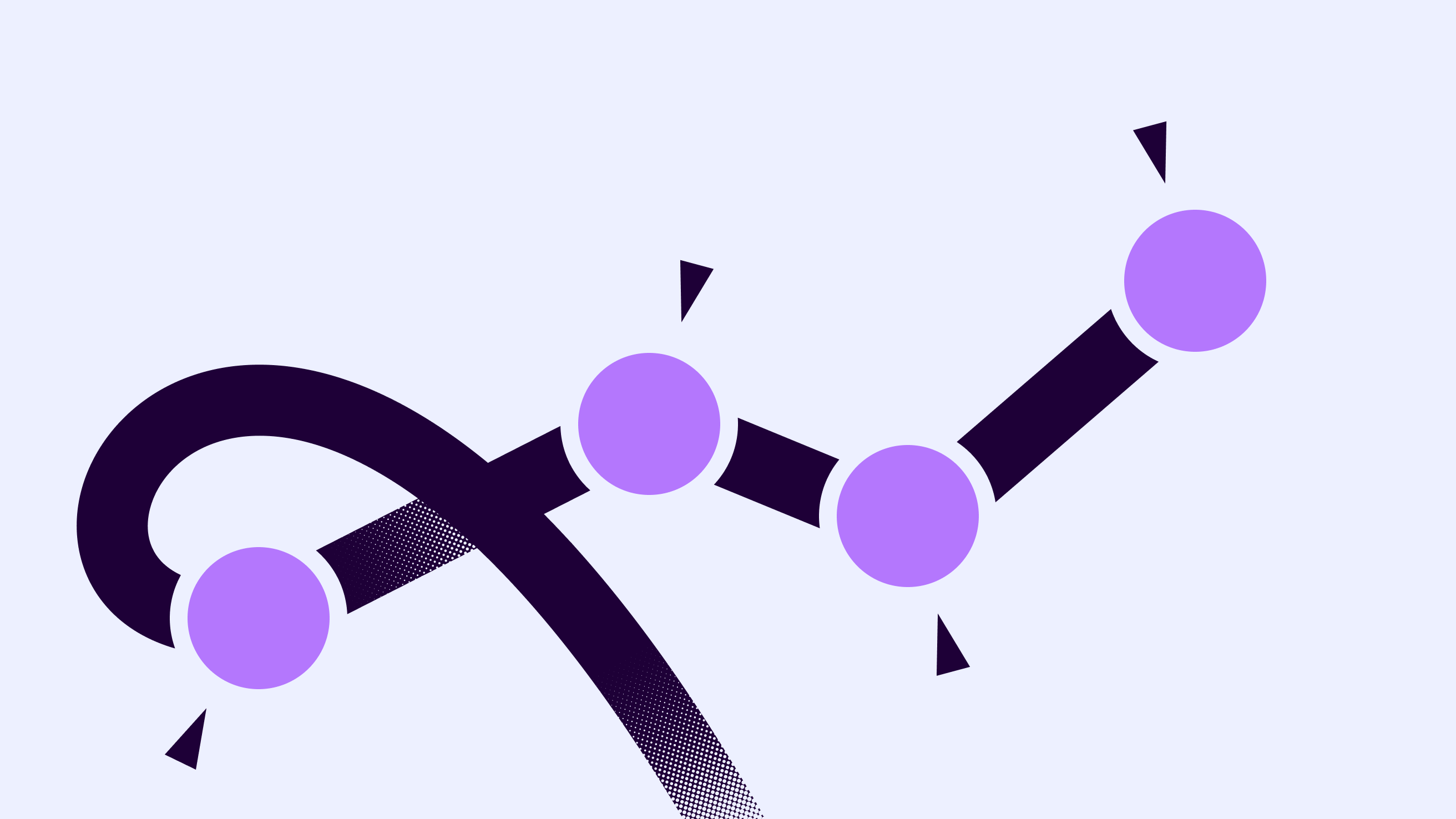
Learn what a career development plan is and how to create it. Discover examples and download the career development planning template in PDF.


Content Marketing Specialist, Valamis
February 1, 2023 · updated July 22, 2024
The idea of an employee remaining in the same role for the entirety of their career seems less relevant with each passing year.
Employees are now looking for more from their professional lives, and employers see benefits in helping them. Organizations can prevent burnout by introducing career development plans and keeping staff motivated with new and exciting challenges.
As a company grows, so should its employees.
A is a personalized roadmap designed to help employees achieve professional goals. It typically consists of short- and long-term goals related to each employee’s specific strengths and weaknesses, their current role, future ambitions, and the organization’s requirements.
While a career development plan can take several formats, they often incorporate a series of formal and informal steps an employee should undertake to improve their professional skills, increase their workplace value, and progress in their career. This could be by expanding their current role and taking on more responsibility or transitioning to a new position.
The personalized nature of career development plans is crucial to their success.
Every employee is unique, with different skills, strengths, and potential within a business and other wants and needs from their professional life.
Organizations must work with employees to design a career development plan that benefits both parties.
The following is a generalized approach to creating and maintaining a career development plan:

A career development plan creates a written record of what an employee wants to achieve.
This record can have a different purpose for employees and employers.

This template helps employees and leaders plan together for career growth: set goals, assess skills, and make a plan.
The importance of learning opportunities and career planning and development has only increased in recent years.
Glint’s 2021 Employee Well-Being Report ranked “opportunities to learn and grow” as the number one driver of excellent workplace culture, up eight spots from the previous year.
In the past, in-person interactions were the primary driver of workplace culture. Team meals, drinks after work, and impromptu chats in the hallway are all examples of interaction significantly reduced with new remote and hybrid work models
The pandemic removed the importance of in-person interactions combined with new technologies and accelerated digital transformation. It created a less certain future, with employees more concerned about job security.
With more significant uncertainty, it is unsurprising that drivers of culture related to employee growth have risen in importance.
Employees now want more than a paycheck and a pat from their employer. They want to perform their work while also getting the opportunity to work on themselves, developing into better employees to help reduce job insecurity worries.
Career development plans and associated training programs help staff see their role as more than just a job. It is a path to a more secure or financially rewarding position.
Investing in employee development is critical to maintaining a vibrant and effective team. Achievers’ 2020 Engagement & Retention Report found:
One way to dispel these feelings is to invest in employee development, demonstrating that the company values workers. With active L&D programs, organizations can boost employee retention and hold on to their most valuable team members.
LinkedIn found that 94% of employees would continue to work at a company for longer if they invested in their learning and development. For ten years, the Work Institute has ranked career development concerns as the number one reason employees leave organizations .
Employers need to treat and guide their L&D programs with career development plans because it helps attract and retain top talent.
This is before they even consider the potential performance benefits of career development programs and how they can inform upskilling and reskilling initiatives.
Perhaps just as bad as talented employees leaving is unskilled, unmotivated employees remaining at your company.
Gallup’s 2022 report on the “State of the Global Workplace” estimates that actively disengaged employees cost the global economy $7.8 trillion, 11% of the world’s GDP .
In contrast, the benefits of high employee engagement are startling. By analyzing over one hundred thousand business units and comparing the top quartile to the bottom quartile, Gallup found:
Thankfully employee development is a crucial driver of engagement, with previous studies showing that 80% of employees are more engaged when learning new skills.
Employee upskilling programs make people better at their job, boosting engagement and arming staff with the skills needed to enhance company performance.
Career development plans ensure that upskilling targets people with the right skills. With individualized training based on an employee’s long-term goals, companies can build a talented, engaged, and happy workforce capable of delivering success.

This template helps employees and leaders plan together for career growth: set goals, assess skills, and make a plan.
Career development plans benefit both the employer and the employee when implemented correctly. Therefore, you should work with your staff to help them accomplish their goals and become well-rounded, successful employees.
While employees must take responsibility and drive their own career development, organizations can also create an environment conducive to learning new skills.
This includes:
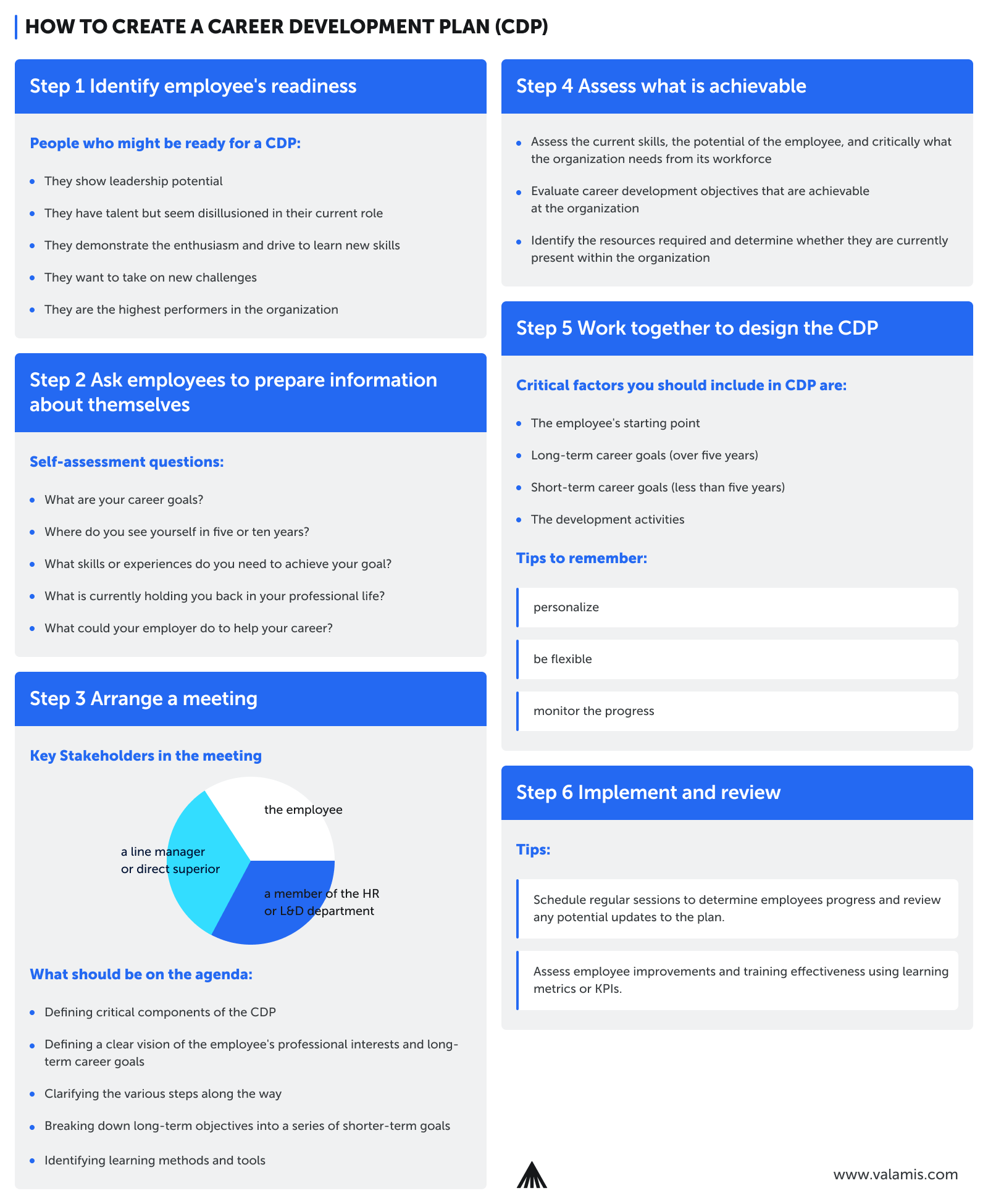
Producing a personalized plan for every employee is a significant undertaking, and for many employees, it may yield little value to the organization. It is always beneficial to focus time and resources where they will be most effective; this could be people who:
Discuss with managers and supervisors from each department to identify candidates who would benefit the most from a dedicated career development plan. Reach out to the candidates and gauge their willingness to work closely with the organization and build a new career development plan.
While it is a team effort between the organization and the employee, ultimately, the individual will drive the success of their career development plan. Therefore, you should ask them to start preparing information about their current role and what they want to achieve in their career.
Essential questions for employees to ask themselves before working on a career development plan include:
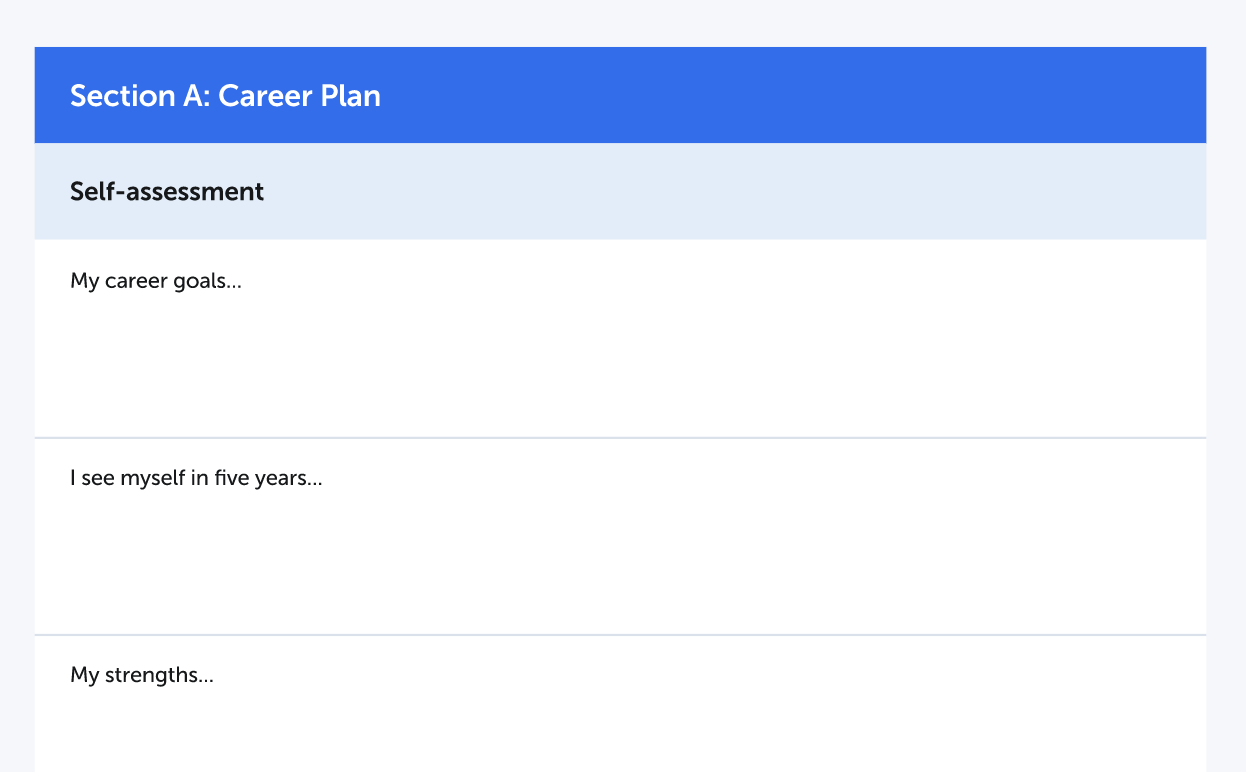
To simplify the process, employers should provide a self-assessment form containing all the information they need to start designing their career development plan. This includes questions identifying the specific skills they currently have and what they will need moving forward.
The next step is to arrange a meeting between key stakeholders, the employee themselves, their line manager or direct superior, and often a member of the HR department.
During the meeting, the parties should go over the information compiled in step 2 and begin to define critical components of the career development plan.
This includes a clear vision of the employee’s professional interests and long-term career goals.
While it is generally easier to define start and end points, the aim of the meeting should be to begin to understand the various steps along the way. This means breaking down long-term objectives into a series of shorter-term goals and how they can be achieved.
Gather information on how the employee likes to learn and consider what their future L&D program may look like with input from HR personnel.
After meeting with the employee, the organization (in particular, the manager involved) needs to determine what they can achieve while working for them.
That means assessing their current skills, the employee potential, and critically what the organization needs from its workforce. For example, only some employees can have a career progressing to the c-suite.
Consult with relevant stakeholders and evaluate career development objectives that are achievable at the organization.
Identify the resources required to help the employee progress towards their career goals and determine whether they are currently present within the organization. In many instances, you will also need to look externally (i.e., external education and learning experiences).
Discuss with the employee and learn how the organization could best support their career development, including the potential resources available. Then start working together to produce a realistic career development plan that helps them achieve their goals.
While there are many potential forms a career development plan can take, critical factors you should include are:
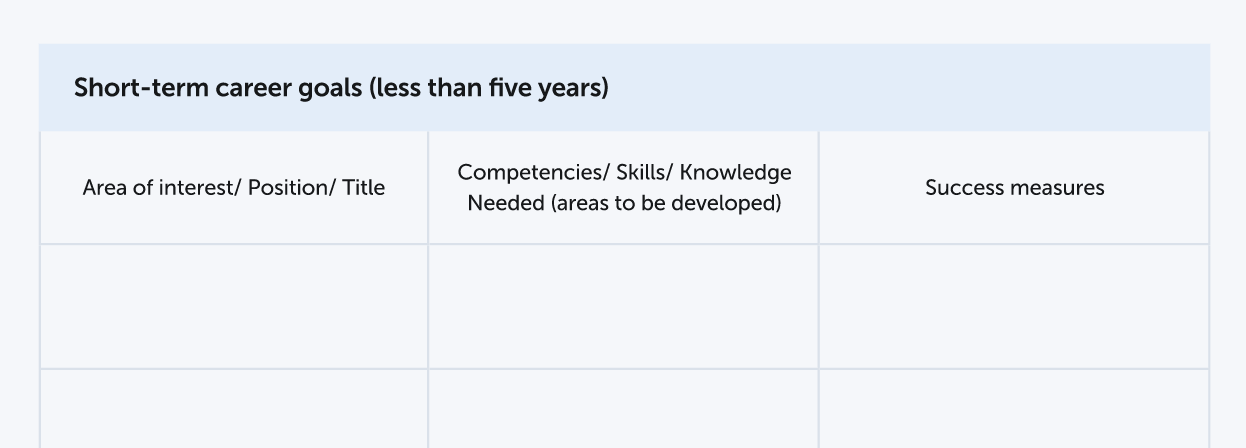
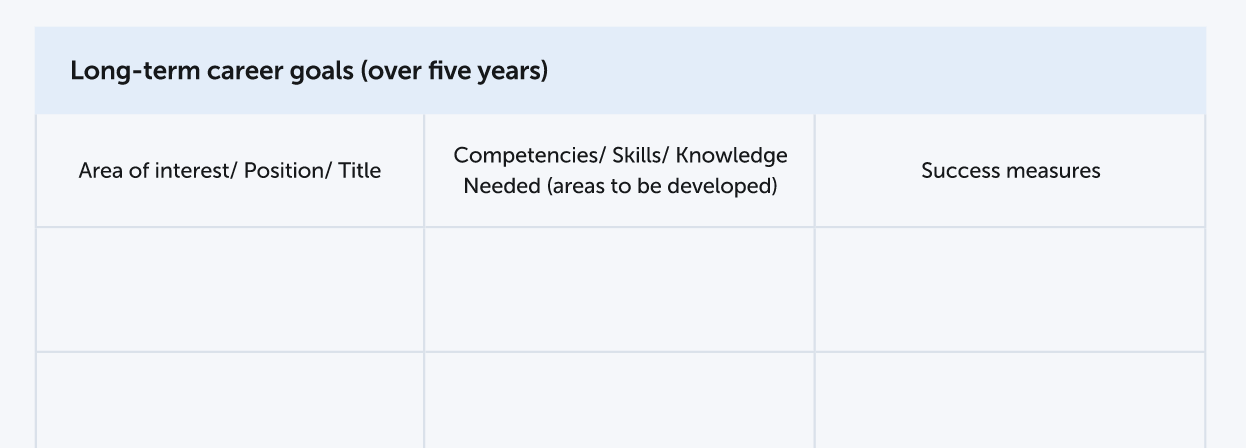
Important tips to remember when designing a career development plan include:
Finally comes the exciting part of implementing the career development plan. Ensure all stakeholders are happy with the program’s current form, then let the development begin.
While you can take steps to support each employee along their career development journey, success has to be driven by the individual.
Make sure to check back with each employee, scheduling regular sessions to determine their progress and review any potential updates to the plan.
Using learning metrics or KPIs, you must also assess employee improvements and training effectiveness. With metrics in place to track behavior, you can determine the return on investment for your L&D efforts.
While employees should continuously evaluate their skills, workplace experience, and career progression, there are better times for employers to engage with them to produce a more formal career development program.
Often a good time to start thinking about a career development plan is once an employee begins to impress management. When they have demonstrated their capabilities and become a valuable team member, management and HR should consider working on a personalized career development plan that maximizes an employee’s potential within the organization.
Another good time to start working on a career development plan is after a significant milestone at the company. Perhaps they land a major client or design a new workflow to improve operations. Whatever the specific reason, by setting future development goals, you can keep essential staff motivated and engaged and prevent them from drifting or looking for a new challenge at another company.
Our Career Development Plan (CPD) template is designed to help both employees and supervisors plan and structure career development effectively.
It encourages collaboration, offering a systematic approach to achieving career milestones that benefit everyone involved.
Empowerment for Managers: Supervisors receive guidance and resources to support their team’s growth journey.
Guidance for Employees: Take control of your career with an easy-to-follow, step-by-step process.
A clear framework for setting and achieving career goals.
Sections to assess current skills, experience, and qualifications.
Space to create an actionable plan for achieving career objectives.
Download our template, which will be a good tool for working on a plan. It helps key stakeholders keep all the data in one place.
You can use the template in different formats.
Did you like it? Help us spread the word!